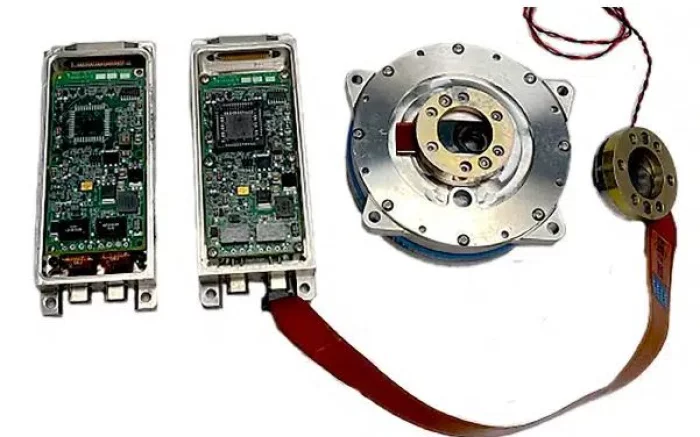Flight Termination System (FTS)
Out FTS' are designed to effectively protect a system and will prevent inadvertent initiation of a Flight Destruct/Termination System (FTS) or rocket motor ignition. They will work only on command and when commanded.
Description
More Products & Services
Products & Services
Explosive Bolts
PacSci EMC
Explosive bolts efficiently secure two objects and strategically explode, jettisoning those objects on command when commanded. These bolts initiate a perfect failure at the pivotal moment they need to. This part is designed for missile, launch vehicles, spacecraft and marine applications where rapid structure separation is demanded. Standard explosive bolts and ridge cut explosive bolts are available in a wide range of sizes, configurations and tensile capacities from as little as 200 pounds to as much as 1,000,000 pounds. As an explosive bolt manufacturer, our experts are here to support you in meeting your structural loading, envelope and environmental requirements and guide you on ways to mitigate shrapnel and products of combustion.
Electronic Ignition Safety Device (eISD)
PacSci EMC
The electronic Ignition Safety Device (eISD) contains an integral Exploding Foil Initiator (EFI) co-located in the same mechanical package, and therefore is close coupled (extremely low inductance and resistance) for extremely high reliability functioning. The eISD is part of a distributed Electronic Safe and Arm Device (ESAD) with one Central ESAD and multiple Remote eISDs. The remote eISDs are Arm/Fire devices that receive a high voltage low current input from the central ESAD and charge up the high voltage circuitry to a desired voltage, then when commanded, eisd discharges this energy into an EFI. We have an EFI design that includes an internal Thru Bulkhead Initiator (TBI) capable of withstanding rocket motor back-pressure after functioning.
The eISD includes High Side Static P-Channel Switch, Low Side Static N-Channel Switch and an N-Channel Dynamic switch to comply with MIL-STD-1901A. These inhibits are unique to meet the safety board requirements. The dynamic inhibit is controlled by the proper sequence of the other two inhibits. A communication bus is utilized to select the appropriate remote ISD to function. Each networked bus allows for up to 48 multiple point remote eISDs to be connected. Each eISD is independently Armed and Fired with very precise timing of events. The unique inhibits can be controlled from Acceleration, Break-wires, switches etc. Our designs can be completely interchangeable with most standard legacy ISD designs.
The eISD includes High Side Static P-Channel Switch, Low Side Static N-Channel Switch and an N-Channel Dynamic switch to comply with MIL-STD-1901A. These inhibits are unique to meet the safety board requirements. The dynamic inhibit is controlled by the proper sequence of the other two inhibits. A communication bus is utilized to select the appropriate remote ISD to function. Each networked bus allows for up to 48 multiple point remote eISDs to be connected. Each eISD is independently Armed and Fired with very precise timing of events. The unique inhibits can be controlled from Acceleration, Break-wires, switches etc. Our designs can be completely interchangeable with most standard legacy ISD designs.
Electronic Safe & Arm Device (eSAD)
PacSci EMC
Utilized with our Bulk Destruct Charge or Linear Shaped Charge, our fully electronic device interfaces with a flight termination receiver, or mission controller, through a customizable input connector. This device outputs a high voltage firing current to initiate single or dual Low Energy Exploding Foil Initiators (LEEFIs). Our ESADs can be integral with the LEEFI energetic output or can initiate the LEEFIs through a high voltage flex tip. Also referred to as a high-energy electronic initiator firing unit, this device meets safety board requirements by incorporating two unique inhibits that must be satisfied prior to firing. Both “armed on the ground” and “armed after safe separation” approved variants are available.
This is the only Safe and Arm Device (SAD) considered to be an “In-Line” SAD. Sandia developed an enabling technology in the 90s called an “Exploding Foil Initiator” which does not depend on heat to ignite the pyrotechnic. Instead it uses an insensitive secondary explosive which is directly initiated with a high velocity detonation impact. The high velocity flyer is generated by discharging very high current (>1000A) through a small reactive semiconductor which then explodes and propels a tiny flyer at velocities greater the 3000m/s into the explosive pellet. Due to the insensitivity of this technology and the very specific electrical impulse required to fire it the US safety board community allowed for the use of an all electronic firing system without the need for mechanical/physical barriers.
Arming requires 3 MOSFETs to close to charge the high voltage capacitor.
This is the only Safe and Arm Device (SAD) considered to be an “In-Line” SAD. Sandia developed an enabling technology in the 90s called an “Exploding Foil Initiator” which does not depend on heat to ignite the pyrotechnic. Instead it uses an insensitive secondary explosive which is directly initiated with a high velocity detonation impact. The high velocity flyer is generated by discharging very high current (>1000A) through a small reactive semiconductor which then explodes and propels a tiny flyer at velocities greater the 3000m/s into the explosive pellet. Due to the insensitivity of this technology and the very specific electrical impulse required to fire it the US safety board community allowed for the use of an all electronic firing system without the need for mechanical/physical barriers.
Arming requires 3 MOSFETs to close to charge the high voltage capacitor.
Cutters
PacSci EMC
A pyro cutter uses energetic materials and a cutting blade to sever objects. It is a cartridge actuated device which, when initiated, will sever/cut a multitude of materials and cross-sectional shapes. Common targets used with ordnance cutting devices include: steel, electrical or fiber optic cables, aluminum, titanium, copper, Kevlar, vectran, zylon, bolts, tubes and woven fiber cords/lines and straps.
The key factors for the cutter are the design of the cutter blade and the control of the cutting capacity to ensure that the bolts can be completely cut.
The design of a pyrotechnic cutter is an actuating component of a hold-down and release device, and it consists of an igniter, a casing, a detonator, a shear pin, a sealing ring, a cutter, a cutting board, and an end cover.
The key factors for the cutter are the design of the cutter blade and the control of the cutting capacity to ensure that the bolts can be completely cut.
The design of a pyrotechnic cutter is an actuating component of a hold-down and release device, and it consists of an igniter, a casing, a detonator, a shear pin, a sealing ring, a cutter, a cutting board, and an end cover.
People
Description
Every day missions are at stake, lives must be protected and personnel must come home. Range Commander Council RCC-319 provides for the safety of people and missions during launch and flight operations. In the event of an errant flight, a Flight Termination System (FTS) renders each power stage and/or propulsion system non-propulsive. We walk every customer through RCC-319 requirements they need to satisfy, ensuring mission assurance.
From concept development through qualification, we partner with you to provide an FTS solution that best fits your needs. Teaming with you while presenting your system solution to Range Safety, we ensure flight certification. We leverage our flight heritage offering a low risk, best value solution; an FTS which is safe, qualified and functions on command, when commanded. From off the shelf to custom designed solutions, your success is our mission. Not only will our experience and expertise be available, but our products have also been designed to meet the strictest of technical requirements and been proven to work in the harshest of environments. Tap into our wealth of knowledge and expertise to ensure the safety protocols of your mission are met.
Whether utilizing an autonomous flight termination unit (AFTU) or a flight termination system (FTS) we can provide the critical components required to take flight termination actions such as thrust termination or pyrotechnic detonations.
From concept development through qualification, we partner with you to provide an FTS solution that best fits your needs. Teaming with you while presenting your system solution to Range Safety, we ensure flight certification. We leverage our flight heritage offering a low risk, best value solution; an FTS which is safe, qualified and functions on command, when commanded. From off the shelf to custom designed solutions, your success is our mission. Not only will our experience and expertise be available, but our products have also been designed to meet the strictest of technical requirements and been proven to work in the harshest of environments. Tap into our wealth of knowledge and expertise to ensure the safety protocols of your mission are met.
Whether utilizing an autonomous flight termination unit (AFTU) or a flight termination system (FTS) we can provide the critical components required to take flight termination actions such as thrust termination or pyrotechnic detonations.

Share
Recent Chats
Share via email
Future: handle WhatsApp here
Future: handle LinkedIn here
Future: handle Twitter here
SUBMENU HERE
Share via Chat
Copy Link


